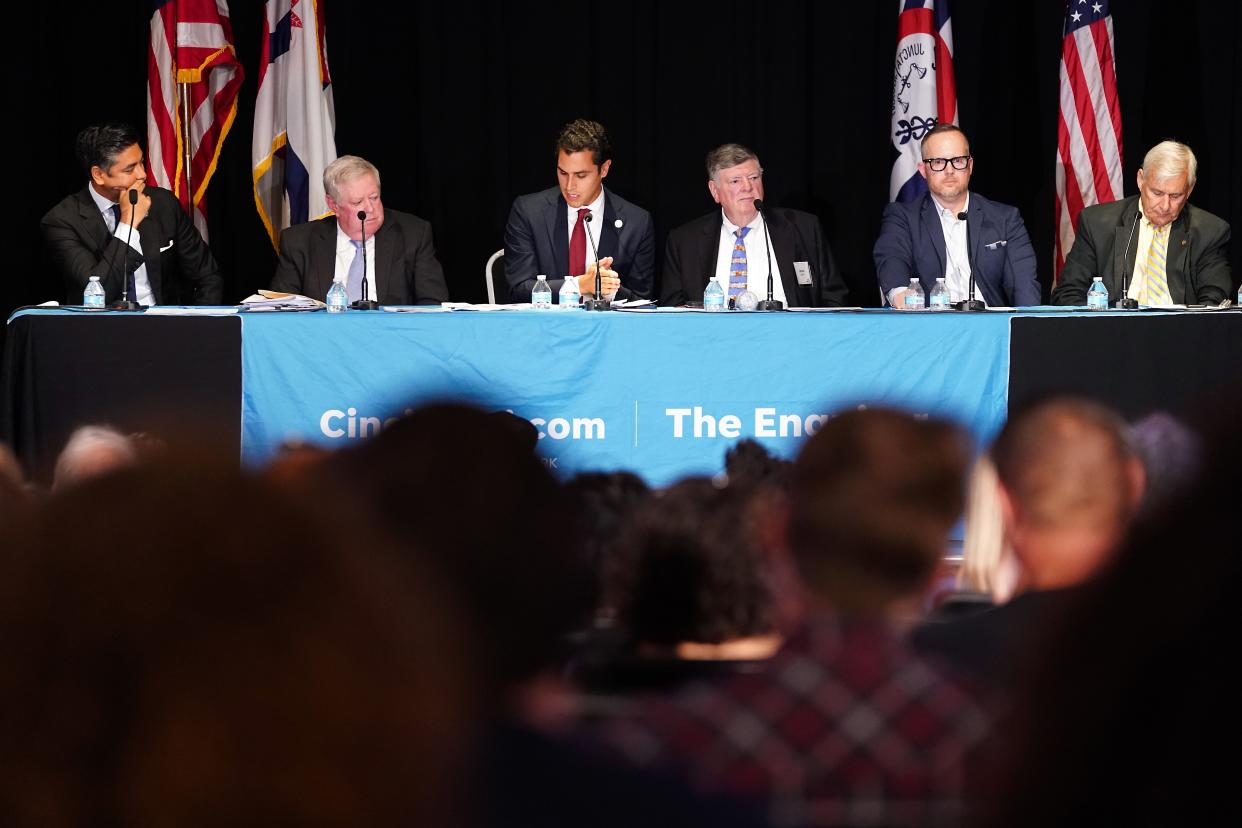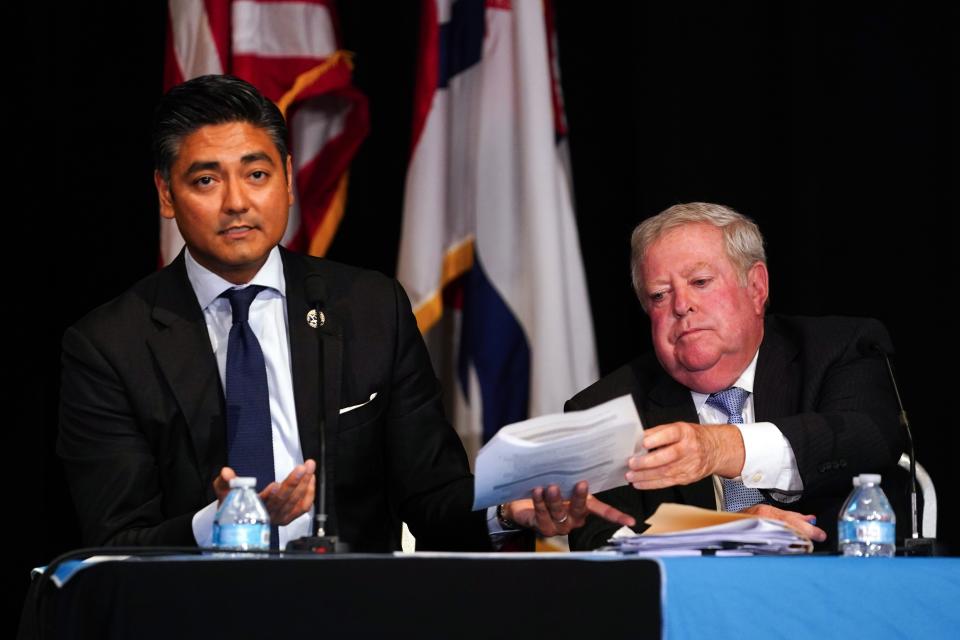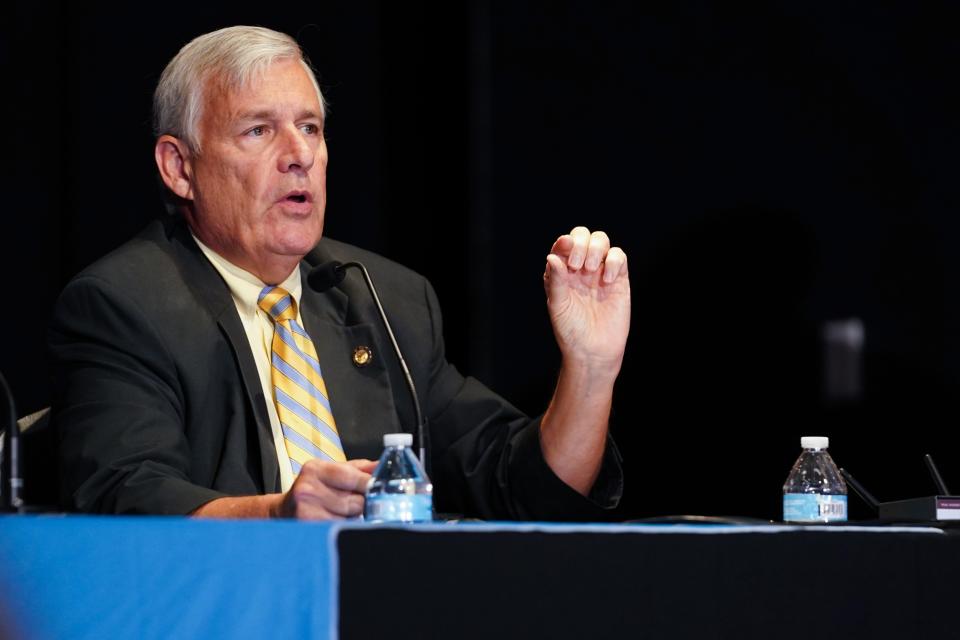Issue 22: At lively debate, panel clashes over Cincinnati plan to sell railway for $1.6B

- Oops!Something went wrong.Please try again later.
In a month, Cincinnati voters will make a historic real estate decision.
If voters say "yes" on Issue 22, Cincinnati would sell its 143-year-old railway for $1.6 billion to Norfolk Southern Corp.
Supporters and opponents of Issue 22 gathered Tuesday evening in Union Terminal, one of the nation's most iconic and historic railroad stations. At an Enquirer-sponsored forum, the two sides pleaded their cases for why the voters should either sell or keep the Cincinnati Southern Railway.
Here's what you need to know about the proposed railway sale and what came out of Tuesday's forum.
A passionate anti-sale crowd showed up
A sale of this magnitude and the ramifications for future generations of Cincinnatians stirred emotions among the more than 100 people who showed up Tuesday night.
A majority of the crowd who filled the auditorium opposed the sale, cheering the opponents of the sale while jeering Cincinnati's mayor and other proponents of the sale.
At the conclusion of the hour-long program, the crowd broke into a chant, "Vote no! Vote no!"
What is the Cincinnati Southern Railway?
The city of Cincinnati owns the Cincinnati Southern Railway, which extends 337 miles from Cincinnati to Chattanooga and is the only municipal-owned railroad in the country.
It's overseen by a five-member board selected by the mayor. Since it was built in the 1870s, the city has received millions each year from the lease of the railroad tracks. The board has long leased it to Norfolk Southern Corp. and the current lease, which brings in roughly $25 million a year, expires in 2026.
Why does the city want to sell it?
The current lease gives Norfolk Southern the sole right to the next lease. During negotiations, Norfolk Southern offered to buy the railroad and the board agreed at a price of $1.6 billion. The plan is to create a trust, then spend investment money from the trust on infrastructure needs, which is estimated at anywhere from $50 million to $80 million a year. The city plan is based on an estimate of the return being $56 million a year.
The board agreed to the sale, but citizens have to approve it in the November election.
Who supported it?
Cincinnati Mayor Aftab Pureval, Cincinnati Southern Railway Board President Paul Muething and Democratic state Rep. Dani Isaacsohn sat on the six-member panel Tuesday night to argue in favor of Issue 22.

Rat-infested health center would get help
The investment returns on the $1.6 billion trust fund would pay for repairs to roads, parks, health centers and other existing infrastructure for the next century, supporters said. Without it, the city won't be able to make needed investments, Pureval said.
To highlight who would benefit, Pureval pointed to people in Over-the-Rhine who get primary health care at the Bobbie Sterne Health Center. The health center has a rat problem requiring rat traps to be placed throughout the center, Pureval said.
"Imagine the neediest people in the city trying to get access to health care and having to go to a health center that has a rat problem," Pureval said. "If we sell the railroad, we’ll have $10 million to invest into the Bobbie Sterne Health Center."
The revenue from the $1.6 billion sale would also pay for 100 miles of roads each year, five times more than what the city currently paves annually, Pureval said.
The $250 million "Cincy on Track" plan under discussion by Cincinnati City Council includes big-ticket repairs to parks, health center renovations, park upgrades and $48 million for street repairs over 10 years.
Who opposed it?
Those who represented the opposition to Issue 22 on the six-member panel were Adam Koehler, a member of the Save our Rail group, Tom Brinkman, a former state lawmaker who recently brought a lawsuit against the railway board, and Alfred Nippert Jr., a retired attorney who serves on the board of directors of the Lebanon, Mason and Monroe Railroad and is a member of the American Association of Private Rail Car Owners and the Railroad Passenger Car Alliance.

Skeptics question whether there's a better deal
The opposition questioned whether the investment returns would actually bring in the $50 million to $80 million annually projected. Inflation will take a big bite out of the returns, Koehler said.
They feel the city could get a better deal. Brinkman bemoaned the lack of public hearings for the sale.
"There are folks out there lurking that are more than happy to put a great bid for this," Brinkman said. "But we don’t know because they didn’t put up competitive bidding."
Nippert said the value and importance of the railway will go up with time, particularly as more freight goes through an expanded Panama Canal and ports along the Gulf of Mexico and Atlantic Ocean coast.
"All of those ports are container ports. That’s the real value behind this," Nippert said. "Why we would sell it before we see the realization of this need? Because that’s going to push the value up."
Norfolk Southern offered $37 million a year
During lease negotiations with the Cincinnati Southern Railway board, Norfolk Southern offered to pay the city of Cincinnati $37 million a year, Muething, the board chair, said on Tuesday.
Opponents seized on that, saying that guaranteed payment would've been a good deal.
If Issue 22 fails, Muething said he doesn't know whether Norfolk Southern would make a similar offer.
East Palestine lingers over Issue 22
The safety concerns in the aftermath of the toxic chemical spill from a February train derailment in East Palestine, Ohio loomed over the proceedings on Tuesday. A man in the audience held up a cardboard sign that simply said "East Palestine." The sale of the railway would go to Norfolk Southern, the same operator of the train that crashed in East Palestine.
Pureval said the sale would not affect safety as the city has no regulatory authority over the railroads. It's a federal oversight issue. The sale of the railway would protect the city from liability should an accident occur.
"I want nothing to do with Norfolk Southern," Pureval said as he started to get drowned out with dissent from the audience. "I want a divorce from Norfolk Southern."
That argument didn't convince Brinkman and the other opponents.
"You don't negotiate with terrorists," Brinkman said. "You don't negotiate with bad actors. Norfolk Southern is a bad actor."
This article originally appeared on Cincinnati Enquirer: What is Issue 22 on the sale of the Cincinnati Southern Railway?

